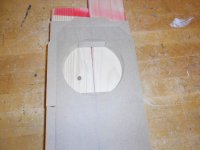How does one make cutouts for the Tang Band W4-1757SB?
An externally hosted image should be here but it was not working when we last tested it.
What, like back on post #24?
Need to cut a scrap piece the speaker will fit all the into - this is the hardest part. Think about how the this "guide" will fit on/over the box for easy clamping.
Next use a bearing on top router bit, follow the guide.
OR find a buddy with a C&C router, take him some beer and ask him to cut it.
Need to cut a scrap piece the speaker will fit all the into - this is the hardest part. Think about how the this "guide" will fit on/over the box for easy clamping.
Next use a bearing on top router bit, follow the guide.
OR find a buddy with a C&C router, take him some beer and ask him to cut it.
cotdt,
To me looks possible with a router assisted by an accessory like the Jasper Jig (for the curved part) and straight cuts. Disclaimer: I have done circular cuts with Jasper Jig only, no experience with truncated driver frames.
Another idea might be use a thin extra layer of ply/mdf/cork on top of your main baffle. Cut out the frame from the thin layer (should be easier to do), paste the thin layer on top of the main baffle in right position so you get the driver flush mounted.
Good suggestion on friend with CNC router by O'Dougbo!
To me looks possible with a router assisted by an accessory like the Jasper Jig (for the curved part) and straight cuts. Disclaimer: I have done circular cuts with Jasper Jig only, no experience with truncated driver frames.
Another idea might be use a thin extra layer of ply/mdf/cork on top of your main baffle. Cut out the frame from the thin layer (should be easier to do), paste the thin layer on top of the main baffle in right position so you get the driver flush mounted.
Good suggestion on friend with CNC router by O'Dougbo!
Sorry, but they can't.
how would you go about testing it?
Looking around the net, it seems you'd need to produce 155db. One thing that's very unrealistic about movies (ha, one thing, there are many unrealistic things) is the use of guns without hearing protection and the SPL playback. Those scenes when everyone is firing away like it's nothing, well, that's just not the case. Your ears are ringing after even one shot. I did it once, and never again. I'll always use hearing protection. (I was like, 20 years old and stupid, well, I'm still stupid. But I was really stupid back then).
actually, being male, 20 and not doing stupid things would be the big news
thankfully, there was no You-Tube when our cohort was that age
Ha, this makes me laugh.
I think youtube hadn't come around yet when I was 20. Maybe. I did have one friend with a digital camera though...


Member
Joined 2009
Paid Member
How does one make cutouts for the Tang Band W4-1757SB?
It's actually pretty easy providing that the curved parts of the speaker flange lie on the same circle. In other words, if there were no 'flat parts' the outer flange would be a circle, like most other drivers.
You will use a regular router with a guide (you can DIY your own guide) for making circular cut-outs.
Draw the circle in pencil first (use a compass, or make a compass) which has the same diameter as the curved part of the driver flange. and mark the points where the driver cut out changes from an arc to a straight chord.
Route the circular arcs, stopping before you cut into the wood where the shape changes to a straight chord. You will need to route several concentric circular arcs so as to remove all the wood from underneath the curved part of the flange, back to where the hole through the baffle will go.
Then clamp a piece of straight edged wood to guide the router for the straight sections of the flange and route those - joining the already routed circular arcs. You may need to move the wooden guide towards the centre of the circle and cut parallel lines until you've removed all the wood from where the flange will go.
Then route the hole in the baffle that the driver will sit inside, being careful at the last cut because this will usually 'free up' the centre anchor point your are rotating your router guide around.
I did it this way for my AN 15" driver: http://www.diyaudio.com/forums/full-range/217893-bigun-audio-nirvana-super-15-a-4.html#post3129267
posts 76, 205, show some images but not the method and the 'flat' bits were relatively small but the method should work for any sized flat bit.
Last edited:
What, like back on post #24?
Need to cut a scrap piece the speaker will fit all the into - this is the hardest part. Think about how the this "guide" will fit on/over the box for easy clamping.
Next use a bearing on top router bit, follow the guide.
pattern following bit
An externally hosted image should be here but it was not working when we last tested it.
the best use of 1/2" MDF I can think of is for the patterns - it always takes several times longer to make a perfect pattern /jig than to route / machine a single set of parts, and a quality bit could cost more than the material for a pair of enclosures, but then you're good for as many pairs as you can stand/afford to build.
bingo - it's amazing what you can get done on a coffee break in exchange for even just a 6 packOR find a buddy with a C&C router, take him some beer and ask him to cut it.
That reminds me; on a simple circle with 2 flats, go ahead cut the templete (circle) the full size. As per Bigun thought, can come back and glue 2 small pieces on the inside e.g. (| |)
Then use the router bit.
Then use the router bit.
It's actually pretty easy providing that the curved parts of the speaker flange lie on the same circle. In other words, if there were no 'flat parts' the outer flange would be a circle, like most other drivers.
You will use a regular router with a guide (you can DIY your own guide) for making circular cut-outs.
Draw the circle in pencil first (use a compass, or make a compass) which has the same diameter as the curved part of the driver flange. and mark the points where the driver cut out changes from an arc to a straight chord.
Route the circular arcs, stopping before you cut into the wood where the shape changes to a straight chord. You will need to route several concentric circular arcs so as to remove all the wood from underneath the curved part of the flange, back to where the hole through the baffle will go.
Then clamp a piece of straight edged wood to guide the router for the straight sections of the flange and route those - joining the already routed circular arcs. You may need to move the wooden guide towards the centre of the circle and cut parallel lines until you've removed all the wood from where the flange will go.
Then route the hole in the baffle that the driver will sit inside, being careful at the last cut because this will usually 'free up' the centre anchor point your are rotating your router guide around.
I did it this way for my AN 15" driver: http://www.diyaudio.com/forums/full-range/217893-bigun-audio-nirvana-super-15-a-4.html#post3129267
posts 76, 205, show some images but not the method and the 'flat' bits were relatively small but the method should work for any sized flat bit.
- Status
- This old topic is closed. If you want to reopen this topic, contact a moderator using the "Report Post" button.
- Home
- Loudspeakers
- Full Range
- How good are fullrange for movies?
